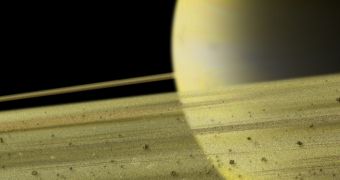A recent study used a computer simulation in order to prove that the rings of Saturn had formed billions of years ago, when the solar system was young, rather than 100 million years ago, while dinosaurs were still alive and well. Also, the research points out that they are three times more massive than previously thought.
The analysis concurs with the data obtained from the Cassini-Huygens spacecraft, which is currently observing Saturn and its 60 moons (out of which 22 are regular satellites). A team comprised of Larry Esposito and Joshua Elliott, and another one consisting of Glen Stewart and Stuart Robbins, all from the University of Colorado, created accurate models of meteorites crashing on the planet's rings, and their study suggests that, instead of the expected ring dissipation after impact, a process of clumping may occur after collision, ensuring a cyclical phenomenon.
Because of their young and "unharmed" look, scientists thought that Saturn's rings couldn't be much older than 100 million years, but recent research shows that, because the dust and debris caused by perpetual meteorite smashes during billions of years is constantly (re-)clumped, the rings don't get dark and dusty. Esposito, who is the main investigator of Cassini's Ultraviolet Imaging Spectrograph (UVIS) device, states, "Both Cassini observations and theoretical calculations can allow the rings of Saturn to be billions of years old. This means we humans are not just lucky to see rings around Saturn. This would lead us to expect massive rings also to surround giant planets circling other stars." Among the other planets that have rings are Uranus, Jupiter and Neptune, but there are scientists who think that it's possible that even Earth may have had them at some point.
Based on how much light gets blocked by the rings of Saturn, specialists previously estimated their mass to be three times less than the current study, because those observations did not take into account the clumping factor.
There are two theories on the formation of Saturn's seven rings: one places their birth at the same time the planet was formed (as its leftover debris trapped by its gravity), while the other, also proven by Cassini data, estimates that they're the remains of the collision of some icy moons, which constantly broke apart into smaller fragments ever since.

 14 DAY TRIAL //
14 DAY TRIAL //